Henry Farny
Henry François Farny (15 July 1847, Ribeauvillé – 23 December 1916) was an American painter and illustrator. His work was centered on the life of Native Americans in the 19th-century United States.[1]
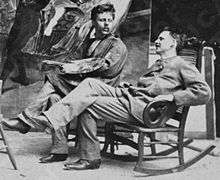

Biography
Farny's family left France in 1853 to emigrate to the United States. The family moved to Warren in Pennsylvania, near a Seneca reservation. As a child he learned the lore of the woods from Seneca Indians, who came from their reservation to hunt in the neighborhood where his father lived. In his boyhood he was fond of covering the walls of his father's board-house with pictures of animals, birds and Indians, which he scratched with nails or framed by aid of burnt sticks.[1]
Around 1859, the Farny family moved to Cincinnati, Ohio. Attracted by painting and drawing, the young man became an illustrator for magazines and books for children. When he was 18 years old, Harper's Weekly published a double page view of Cincinnati he made.
Between 1867 and 1870 he took private lessons from Albert Bierstadt in Düsseldorf. By the time Farny had arrived at Düsseldorf, and began attending Düsseldorf academy in the late 1860s the Düsseldorf school of painting had already begun to lose its once high acclaim amongst most of the American populace.
One part of America where this was not the case was in Cincinnati, Ohio where the realist objectives taught there were still being held in high esteem. Despite this, upon his return to Cincinnati in 1870 Farny, who had been studying abroad, came home to a minimally responsive demand by Cincinnatians for his paintings. He used his new found skills in the service of poster painting and other odd jobs. In 1873 this all changed when he was commissioned by the chamber of commerce to depict in drawing the different stages of pork packing in Cincinnati.
In 1881, inspired by the developing market for Indian paintings, Farny traveled up the Missouri River, making sketches, taking notes and photography, and collecting artifacts. On several more trips West he did the same, until his Cincinnati studio contained enough material for almost any Indian subject he wished to illustrate.[2] Upon his return to Cincinnati, he remarked: "The plains, the buttes, the whole country and its people are fuller of material for the artist than any country in Europe."[3]
About a hundred paintings were inspired by Farny's western trips in the 1880s. Ration Day at Standing Rock Agency, The Song of the Talking Wire, and The Last Vigil are among his most famous. His understanding of the Indian's plight is often apparent in his work.[3]
Farny was one of the founding members of the Cincinnati Art Club and served as its second president from 1892–94.[4]
Theodore Roosevelt once said to Farny: "Farny, the nation owes you a great debt. It does not realize it now but it will some day. You are preserving for future generations phases of American history that are rapidly passing away."[1]
He died in Cincinnati in 1916.[5]
Style
Farny who was an erudite scholar, and student of both Munich and Düsseldorf's schools of fine arts, nonetheless, can be seen, from his works of art to have assimilated the Düsseldorf techniques of a drab styled realism into his paintings. In his depictions of the post civil war era and oppression of Native Americans at the time, Farny masterfully painted confounding situations, such as a perplexed Indian examining a telephone line. This painting entitled (In song of the Talking wire, a major work of 1904) can be interpreted as 'in the struggle against the white man's technology he must succumb' "John Clubbe". This painting along with one entitled Morning of a New Day which shows Native Americans on a snowy hill watching a far away train have gained Farny a reputation of practicing the 'vanishing race' style of painting.
Legacy
Farny's art continues to gain in popularity and most serious public as well as private Western art collections include at least one painting. Recently his Southern Plains Indian Warrior sold at Bonhams for £224,097 (US$362,500) - more than three times its original estimated value.[6][7]
Artworks
Selected artworks
| Year | Title | Image | Dimensions | Collection | Comments |
|---|---|---|---|---|---|
| 1878 | The Silent Guest, oil on canvas | 40.2 in × 30.1 in (102.2 cm × 76.5 cm) | Cincinnati Art Museum, Cincinnati, OH | IAP 40800019 | |
| 1885 | The Captive, gouache/watercolor | 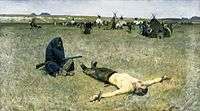 color image | 22.3 in × 40.0 in (56.7 cm × 101.6 cm) | Cincinnati Art Museum, Cincinnati, OH | IAP 40800021 |
| 1887 | The Unwelcome Guests, oil on canvas | 38.0 in × 48.3 in (96.5 cm × 122.7 cm) | Cincinnati Art Museum, Cincinnati, OH | IAP 40800949 | |
| 1888 | The Water Carriers (or Drawing Water), watercolor | 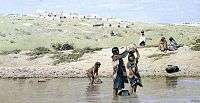 | 8.4 in × 16.1 in (21.3 cm × 40.9 cm) | IAP 62641434 | |
| 1890 | Hunting Camp on the Plains, oil on canvas | 22.1 in × 38.6 in (56.1 cm × 98.0 cm) | Cincinnati Art Museum, Cincinnati, OH | IAP 40800950 | |
| 1891 | Indian Brave, watercolor | 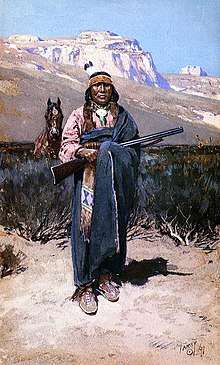 | 10 in × 6 in (25.4 cm × 15.2 cm) | IAP 63003525 | |
| 1892 | Renegade Apaches, oil on canvas | 32.6 in × 22.6 in (82.9 cm × 57.5 cm) | Cincinnati Art Museum, Cincinnati, OH | IAP 40800011 | |
| 1895 | Conspiracy, watercolor | 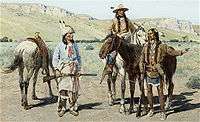 color image | 15.4 in × 9.6 in (39.1 cm × 24.4 cm) | American Heritage Center, University of Wyoming, Laramie, WY | IAP 59040012 |
| 1896 | Chief Spotted Tail (1896?), watercolor | 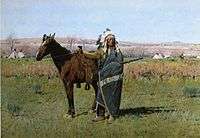 | 10 in × 7 in (25.4 cm × 17.8 cm) or 10.3 in × 15.1 in (26.2 cm × 38.4 cm) | Subject: Chief Spotted Tail (1823-1881), Brulé, branch of Sioux tribe. IAP 82190580 IAP 86040016 | |
| 1896 | Pastures New, watercolor | color image | 12.3 in × 18.3 in (31.2 cm × 46.5 cm) | American Heritage Center, University of Wyoming, Laramie, WY | IAP 59040013 |
| 1899 | Something Stirring, gouache/watercolor | 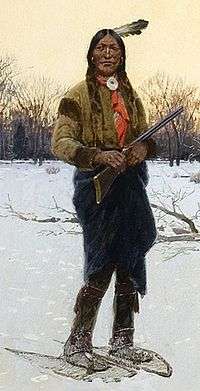 color image | 12.5 in × 9.5 in (31.8 cm × 24.1 cm) | American Heritage Center, University of Wyoming, Laramie, WY | IAP 59040011 |
| 1902 | Big Game in Sight, gouache/watercolor |  color image | 10.6 in × 5.6 in (26.9 cm × 14.2 cm) | American Heritage Center, University of Wyoming, Laramie, WY | IAP 59040005 |
| 1900 | The Old Buffalo Trail, watercolor | 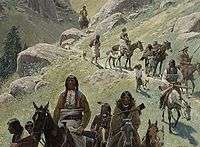 color image | 28.5 in × 20.5 in (72.4 cm × 52.1 cm) | American Heritage Center, University of Wyoming, Laramie, WY | IAP 59040015 |
| 1902 | Indian Elk Hunting, oil on canvas | Cincinnati Art Museum, Cincinnati, OH | |||
| 1905 | Fording a Stream (or Breaking a Pony; or Fording the Stream), oil on canvas | 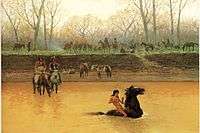 | 21 in × 32 in (53.3 cm × 81.3 cm) | IAP 43590039 | |
| 1906 | The Last of the Herd, oil on canvas | 22.1 in × 38.6 in (56.1 cm × 98.0 cm) | Cincinnati Art Museum, Cincinnati, OH | IAP 40800951 | |
| 1906 | Rounded Up, by God (or Rounded up by God) (1906?), oil | 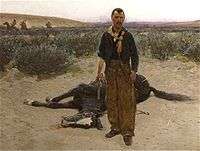 color image | 40 in × 22 in (101.6 cm × 55.9 cm) | American Heritage Center, University of Wyoming, Laramie, WY | IAP 59040006 |
| 1909 | On the Trail Home (or On the Home Trail), oil | color image | 14 in × 24 in (35.6 cm × 61.0 cm) | American Heritage Center, University of Wyoming, Laramie, WY | IAP 59040007 |
| 1910 | Pere Marquette (or Into the Unknown), oil | 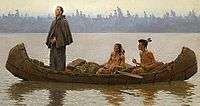 color image | 41.5 in × 23 in (105.4 cm × 58.4 cm) | American Heritage Center, University of Wyoming, Laramie, WY | IAP 59040008 |
| 1911 | The Moment of Suspense (or A Moment of Suspense), oil | 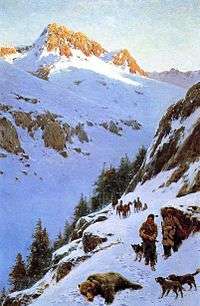 color image | 24 in × 16 in (61.0 cm × 40.6 cm) | IAP 86040041 | |
| 1912 | Departure for the Buffalo Hunt, oil on canvas |  | 22 in × 32 in (55.9 cm × 81.3 cm) | IAP 86040032 IAP 8C280012 | |
| Fort Totten Trail, watercolor | 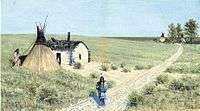 | 8.3 in × 15 in (21.1 cm × 38.1 cm) | IAP 63005226 | ||
| The Thunder Horse, oil | color image | 16.6 in × 24 in (42.2 cm × 61.0 cm) | American Heritage Center, University of Wyoming, Laramie, WY | IAP 59040014 | |
| Silent Guest, oil | 11.7 in × 8.3 in (29.8 cm × 21.0 cm) | IAP 61515285 | |||
References
- Clark, S. J. (1912). Cincinnati, the Queen City, 1788-1912, Volume 2. The S. J. Clarke Publishing Company. pp. 449. Retrieved 2016-03-29.
- "Henry F. Farny". Smithsonian American Art Museum. Retrieved 2016-03-28.
- Dawdy, Doris Ostrander (1974). Artists of the American West. Sage Books. p. 84. ISBN 0-8040-0607-5.
- "Past Presidents". Cincinnati Art Club. Retrieved 2016-03-28.
- Levy, Florence Nightingale (1917). American Art Directory, Volume 14. The American Federation of the Arts. p. 322.
- "Bonhams : Henry F. Farny (American, 1847-1916) Southern Plains Indian warrior, 1894 16 x 11in". www.bonhams.com. Retrieved 2016-03-28.
- "Bonhams : Newly discovered masterwork brings $362,500 during May auction at Bonhams". www.bonhams.com. Retrieved 2016-03-28.
Further reading
- Henry Farny, Inventories of American Painting (IAP), Smithsonian Institution Research Information System (SIRIS)
- Baltzer, Charles. Henry F. Farny. Cincinnati: Indian Hill Historical Museum Association, 1978.
- Carter, Denny. Henry Farny. New York: Watson-Guptill Publications, 1978
External links
| Wikimedia Commons has media related to Henry F. Farny. |